Operation Optimization Model of Regional Power Grid Considering Congestion Management and Security Check in Complex Market Operation Environment
Abstract
1. Introduction
1.1. Background and Motivation
1.2. Literature Review
1.3. Contribution and Innovation
- (1)
- The realistic foundation, special constraints, and needs of security check and congestion management existing in the operating mode changing process of the RPG are expounded. Considering the centralized power market, decentralized power market, fixed power generation plan, and complex operation environment in RPG, the status and challenges of the transition from planned scheduling mode to market-based scheduling mode are analyzed. The basic rules of regional power grid operation and the root cause of power grid congestion in the operation of regional power grids are also explained through a detailed modeling process.
- (2)
- Security checks and congestion management programs of the regional power grid are designed. Facing the specific reasons for congestion in the regional power grid, the principles of the security check mechanism and the framework of RPG security check and congestion management mechanism are put forward. In the three designed programs of security check and congestion management, the operation optimization logic of the regional power grid and the transmission relation of dispatching information is clearly designed, which considers three typical market models, namely, provinces without ESM, provinces with centralized ESM, provinces with decentralized ESM. Based on these, the best program suggestion is given by comparing and analyzing the advantages, disadvantages, and applicable scenarios of each program.
- (3)
- Operation optimization methods that consider congestion management are established for three different security checks and congestion management programs. The operation optimization method established aims to minimize power adjustment and re-adjustment costs of RPG while taking into account existing provincial ESM clearing results. Based on the congestion management model, an IEEE-39 node test system is simulated as an example to verify the effectiveness of the three proposed programs for day-ahead safety check and congestion management.
2. System Structure and Problem Statement
2.1. System Structure
2.2. Problem Statement
3. Security Check Mechanism Design of Regional Power Grid
3.1. Principles of Security Check Mechanism Design
3.2. Framework Design of RPG Security Check and Congestion Management Mechanism
3.2.1. Framework Design of Program 1
3.2.2. Framework Design of Program 2
3.2.3. Framework Design of Program 3
3.3. Program Characteristic Analysis
4. Operation Optimization Model Considering Congestion Management
4.1. Optimization Method for Program 1 and Program 2
4.1.1. Objective Function
4.1.2. Constraint Conditions
- (1)
- Power balance constraints
- (2)
- Rotation reserve constraints
- (3)
- Unit output power constraints
- (4)
- Unit climbing constraints
- (5)
- RPG lines power flow constraints
4.2. Optimization Method for Program 3
4.2.1. Optimization Model of Program 3-1
- (1)
- Objective function
- (2)
- Constraint conditions
4.2.2. Optimization Model of Technical Program 3-2
4.2.3. Model Improvement of Program 3 Considering Minimizing Change of Tie Line Plan
4.3. Model Solving Method
4.3.1. Transformation of Operation Optimization Model Based on MDP
4.3.2. Solving Algorithm Based on Q-Learning
- (1)
- Initialize the value function and set the attenuation factor , learning rate , and exploration rate ε.
- (2)
- Algorithm iteration until converges.
5. Case Study
5.1. Basic Parameters
5.2. Simulation Results of Congestion Management
5.2.1. Congestion Management Result for Program 1
5.2.2. Congestion Management Result for Program 2
5.2.3. Congestion Management Result for Program 3
5.3. Results and Discussion
6. Conclusions
Author Contributions
Funding
Data Availability Statement
Conflicts of Interest
Nomenclature
| Abbreviation | Meaning |
| RPG | Regional power grid |
| ESM | Electricity spot market |
| HP | Hydropower |
| CFP | Coal-fired power |
| TLG | Tie-line gateway |
| RL | Reinforcement learning |
| MDP | Markov decision processes |
Appendix A
| Unit Number | Province A | Province B | Province C | ||||||||
|---|---|---|---|---|---|---|---|---|---|---|---|
| G1 | G8 | G9 | G2 | G3 | G10 | G4 | G5 | G6 | G7 | ||
| Initial output | 886.0 | 480.5 | 736.9 | 196.6 | 725 | 1100 | 652 | 210.1 | 687 | 580 | |
| First adjustment | Adjusted output | 886.0 | 480.5 | 736.9 | 211.6 | 725 | 1100 | 652 | 195.1 | 687 | 580 |
| Unit output adjustment | 0 | 0 | 0 | 15 | 0 | 0 | 0 | −15 | 0 | 0 | |
| Second adjustment | Adjusted output | 886.04 | 480.5 | 736.9 | 226.6 | 725 | 1100 | 652 | 180.1 | 687 | 580 |
| Unit output adjustment | 0 | 0 | 0 | 30 | 0 | 0 | 0 | −30 | 0 | 0 | |
| Unit output adjustment in each province | 0 | 30 | −30 | ||||||||
| Unit Number | Province A | Province B | Province C | |||||||
|---|---|---|---|---|---|---|---|---|---|---|
| G1 | G8 | G9 | G2 | G3 | G10 | G4 | G5 | G6 | G7 | |
| Initial output | 886 | 480.5 | 736.9 | 196.6 | 725 | 1100 | 652 | 210.1 | 687 | 580 |
| Adjusted output | 886 | 480.5 | 715 | 221.2 | 725 | 1100 | 649.4 | 210.1 | 687 | 580 |
| Unit output adjustment | 0 | 0 | −22 | 24.5 | 0 | 0 | −2.5 | 0 | 0 | 0 |
| Unit output adjustment in the province | −22 | 24.5 | −2.5 | |||||||
| Unit Number | Province A | Province B | Province C | ||||||||
|---|---|---|---|---|---|---|---|---|---|---|---|
| G1 | G8 | G9 | G2 | G3 | G10 | G4 | G5 | G6 | G7 | ||
| Initial output | 886.0 | 480.5 | 736.9 | 196.6 | 725 | 1100 | 652 | 210.1 | 687 | 580 | |
| Case 1 | Adjusted output | 1011.0 | 87.5 | 865.0 | 646.0 | 725.0 | 1100.0 | 652.0 | 0.0 | 687.0 | 480.8 |
| Unit output adjustment | 124.9 | −393 | 128.1 | 449.4 | 0 | 0 | 0 | −210.1 | 0 | −99.2 | |
| Unit output adjustment in each province | −140.0 | 449.4 | −309.3 | ||||||||
| Case 2 | Adjusted output | 1040.0 | 411.9 | 651.6 | 196.9 | 725.0 | 1100.0 | 652.0 | 209.9 | 687.0 | 580.0 |
| Unit output adjustment | 154.0 | −68.6 | −85.3 | 0 | 0 | 0 | 0 | 0 | 0 | 0 | |
| Unit output adjustment in each province | 0 | 0 | 0 | ||||||||
| Case 3 | Adjusted output | 851.4 | 480.5 | 736.9 | 231.2 | 725.0 | 1100.0 | 652.0 | 210.1 | 687.0 | 580.0 |
| Unit output adjustment | −34.6 | 0 | 0 | 34.6 | 0 | 0 | 0 | 0 | 0 | 0 | |
| Unit output adjustment in each province | −34.6 | 34.6 | 0 | ||||||||
| Unit Number | Province A | Province B | Province C | ||||||||
|---|---|---|---|---|---|---|---|---|---|---|---|
| G1 | G8 | G9 | G2 | G3 | G10 | G4 | G5 | G6 | G7 | ||
| Initial output | 886.0 | 480.5 | 736.9 | 196.6 | 725 | 1100 | 652 | 210.1 | 687 | 580 | |
| Case 1 | Adjusted output | 967.0 | 32.3 | 865.0 | 646.0 | 725.0 | 1100.0 | 652.0 | 0.0 | 687.0 | 580.0 |
| Unit output adjustment | 80.9 | −448.2 | 128.1 | 449.3 | 0 | 0 | 0 | −210.1 | 0 | 0 | |
| Unit output adjustment in each province | −293.3 | 449.3 | −210.1 | ||||||||
| Case 2 | Adjusted output | 1040.0 | 411.9 | 651.6 | 196.9 | 725.0 | 1100.0 | 652.0 | 209.9 | 687.0 | 580.0 |
| Unit output adjustment | 154.01 | −68.6 | −85.3 | 0 | 0 | 0 | 0 | 0 | 0 | 0 | |
| Unit output adjustment in each province | 0 | 0 | 0 | ||||||||
| Case 3 | Adjusted output | 851.4 | 480.5 | 736.9 | 231.2 | 725.0 | 1100.0 | 652.0 | 210.1 | 687.0 | 580.0 |
| Unit output adjustment | −34.6 | 0 | 0 | 34.6 | 0 | 0 | 0 | 0 | 0 | 0 | |
| Unit output adjustment in each province | −34.6 | 34.6 | 0 | ||||||||
| Case 4 | Adjusted output | 851.4 | 480.5 | 736.9 | 231.2 | 725.0 | 1100.0 | 652.0 | 210.1 | 687.0 | 580.0 |
| Unit output adjustment | −34.6 | 0 | 0 | 34.6 | 0 | 0 | 0 | 0 | 0 | 0 | |
| Unit output adjustment in each province | −34.6 | 34.6 | 0 | ||||||||
References
- Chen, H.; Niu, D.; Du, R. Examining the synergistic mechanisms and effects of energy transformation and industrial development in China. Energy 2024, 313, 124136. [Google Scholar] [CrossRef]
- Ge, C. Can Environmental Protection Tax Promote Urban Green Transformation? Experimental Evidence from China. Sustainability 2024, 16, 9011. [Google Scholar] [CrossRef]
- Zhang, C.; Lai, Y.; Yang, L. A Distributionally Robust Bi-level Optimization Model for Power Market Considering Source–Load Interaction and Carbon Permit Allocation. J. Electr. Eng. Technol. 2024, 19, 4767–4778. [Google Scholar] [CrossRef]
- Xu, Z.; Chen, W.; Ding, J. Optimization path of inte-provincial medium and long-term transaction mechanism in southern China under two-level transaction mode. Electr. Power Autom. Equip. 2022, 42, 175–181. [Google Scholar] [CrossRef]
- Yi, Y.; Zhang, L.; Du, L. Cross-regional integration of renewable energy and corporate carbon emissions: Evidence from China’s cross-regional surplus renewable energy spot trading pilot. Energy Econ. 2024, 135, 107649. [Google Scholar] [CrossRef]
- National Development and Reform Commission Office; National Energy Administration General Office. Notice on Carrying out Pilot Projects of the Electricity Spot Market Construction. 2017. Available online: https://www.ndrc.gov.cn/xxgk/zcfb/tz/201709/t20170905_962552.html (accessed on 5 September 2017).
- National Development and Reform Commission Office; National Energy Administration General Office. Notice on Further Accelerating the Construction of Electricity Spot Markets. 2023. Available online: https://www.ndrc.gov.cn/xxgk/zcfb/tz/202311/t20231101_1361704.html (accessed on 1 November 2023).
- National Development and Reform Commission and National Energy Administration. Guiding Opinions on Accelerating the Construction of a Unified National Electricity Market System. 2022. Available online: https://www.gov.cn/zhengce/zhengceku/2022-01/30/content_5671296.html (accessed on 30 January 2022).
- Liu, Y.; Jiang, Z.; Guo, B. Assessing China’s provincial electricity spot market pilot operations: Lessons from Guangdong province. Energy Policy 2022, 164, 112917. [Google Scholar] [CrossRef]
- Hohl, C.; Prete, C.L.; Radhakrishnan, A.; Webster, M. Intraday markets, wind integration and uplift payments in a regional U.S. power system. Energy Policy 2023, 175, 113503. [Google Scholar] [CrossRef]
- Zhang, Y.; Anvari-Moghaddam, A.; Peyghami, S.; Blaabjerg, F. Novel Frequency Regulation Scenarios Generation Method Serving for Battery Energy Storage System Participating in PJM Market. Energies 2024, 17, 3479. [Google Scholar] [CrossRef]
- Qu, Z.; He, L.; Lu, X.J. A Two-Stage Forecasting Approach for Day-Ahead Electricity Price Based on Improved Wavelet Neural Network With ELM Initialization. IEEE Trans. Ind. Appl. 2024, 60, 5061–5073. [Google Scholar] [CrossRef]
- Chen, H.; Pilong, C.; Rocha-Garrido, P.; Frogg, D.; Jayachandran, M.; Manno, D.; Sexauer, J.; Callaghan, C.; Dropkin, R.; Mulhern, J.; et al. Grid Resilience with High Renewable Penetration: A PJM Approach. IEEE Trans. Sustain. Energy 2023, 14, 1169–1177. [Google Scholar] [CrossRef]
- Lyu, C.; Do, H.; Nepal, R.; Jamasb, T. Volatility spillovers and carbon price in the Nordic wholesale electricity markets. Energy Econ. 2024, 134, 107559. [Google Scholar] [CrossRef]
- Nagel, N.O.; Böhringer, C.; Rosendahl, K.E.; Bolkesjø, T.F. Impacts of green deal policies on the Nordic power market. Util. Policy 2023, 80, 101475. [Google Scholar] [CrossRef]
- Liu, S.; Huang, Y.; Wang, Y.; Shao, Q.; Zhou, H.; Wang, J.; Chen, C. Incentive Mechanisms to Integrate More Renewable Energy in Electricity Markets in China. Energies 2023, 16, 6573. [Google Scholar] [CrossRef]
- Liu, J.; Wang, J.; Cardinal, J. Evolution and reform of UK electricity market. Renew. Sustain. Energy Rev. 2022, 161, 112317. [Google Scholar] [CrossRef]
- Bock, J.; Geissel, S. Evolution of stock market efficiency in Europe: Evidence from measuring periods of inefficiency. Financ. Res. Lett. 2024, 62, 105129. [Google Scholar] [CrossRef]
- Micklitz, H.-W. Book Review: Personal Debt in Europe: The EU Financial Market and Consumer Insolvency, by Federico Ferretti and Daniela Vandone. Common Mark. Law Rev. 2023, 60, 902–904. [Google Scholar] [CrossRef]
- Yu, Y.; Yang, P.; Ceng, K.; Chen, X. Optimal dispatch of power system considering uncertainty of both source and load sides and N-1 security constraint. Renew. Energy 2024, 42, 664–674. [Google Scholar]
- Tyroller, K.; Yalcinoz, T.; Rudion, K. Comprehensive Day-Ahead Marketing Model Considering N-1 Security and Renewables. J. Energy Eng. 2023, 149, 04022042. [Google Scholar] [CrossRef]
- Li, H.; Ren, Q.; Lu, X.; Cao, S. A Novel Power Grid Security Situation Assessment Method for Intelligent Dispatching. In Proceedings of the 2023 IEEE International Conference on Integrated Circuits and Communication Systems (ICICACS), Raichur, India, 24–25 February 2023. [Google Scholar] [CrossRef]
- Cai, Z.; Zhang, G.; Wang, M.; Zhang, C.; Sun, Y.; Sun, Y. Collaborative security check and correction of regional and provincial power grids in power market environment. Proc. CSEE 2023, 43, 3758–3768. [Google Scholar] [CrossRef]
- Wu, D.; Wang, Z.; Gao, W.; Ying, Y. Security check of the whole network in provincial electricity spot market. Electr. Power 2023, 56, 57–65. [Google Scholar] [CrossRef]
- Li, Z.; Wang, X.; Deng, J.; Gu, C.; Yang, J.; Liu, H. Transmission system planning method based on fine modeling of substation grid-connected scheme. Proc. CSEE 2024, 1–16. Available online: https://link.cnki.net/urlid/11.2107.tm.20240719.1309.024 (accessed on 19 July 2024).
- Liu, S.; Lou, N.; Zhang, H.; Gong, K.; Fan, Z.; Yang, L. Real-time security check method of FM market in southern region including third-party independent subject. Autom. Electr. Power Syst. 2024, 48, 153–161. [Google Scholar] [CrossRef]
- Zhang, Y.; Guo, Q.; Zhou, Y.; Sun, H. Online Frequency Security Assessment Based on an Analytical Model Considering Limiting Module. CSEE J. Power Energy Syst. 2021, 8, 1363–1372. [Google Scholar] [CrossRef]
- Lu, Y.; Cai, Z.; Zhang, G.; Ding, Q.; Xiao, C.; Dong, Z. Implementation Scheme of Security Check in Provincial Power Grid Suitable for Operation of Electricity Spot Market. Autom. Electr. Power Syst. 2021, 45, 216–223. [Google Scholar] [CrossRef]
- Alavijeh, N.M.; Steen, D.; Le, A.T.; Nyström, S. Capacity limitation based local flexibility market for congestion management in distribution networks: Design and challenges. Int. J. Electr. Power Energy Syst. 2024, 156, 109742. [Google Scholar] [CrossRef]
- van der Holst, B.; Verhoeven, G.; Nguyen, P.H.; Morren, J.; Kok, K. The activation of congestion service contracts for budget-constrained congestion management. Electr. Power Syst. Res. 2024, 235, 110664. [Google Scholar] [CrossRef]
- Christy, J.; Jeyaraj, P.R. Data-driven adaptive Lyapunov function based graphical deep convolutional neural network for smart grid congestion management. Electr. Power Syst. Res. 2025, 238, 111163. [Google Scholar] [CrossRef]
- Sergio, P.; Orlando, V. Decoding design characteristics of local flexibility markets for congestion management with a multi-layered taxonomy. Appl. Energy 2024, 357, 122203. [Google Scholar] [CrossRef]
- Rahman, A.; Hassan, B.; Ahmad, G. A chance-constrained optimization framework for transmission congestion management and frequency regulation in the presence of wind farms and energy storage systems. Electr. Power Syst. Res. 2022, 213, 108712. [Google Scholar] [CrossRef]
- Attar, M.; Repo, S.; Mutanen, A.; Rinta-Luoma, J.; Väre, T.; Kukk, K. Market integration and TSO-DSO coordination for viable Market-based congestion management in power systems. Appl. Energy 2024, 353, 122180. [Google Scholar] [CrossRef]
- Kaushal, A.; Ergun, H.; Heylen, E.; van Hertem, D. A SCOPF model for congestion management considering power flow controlling devices. Electr. Power Syst. Res. 2022, 212, 108580. [Google Scholar] [CrossRef]
- Dehnavi, E.; Afsharnia, S.; Akmal, A.A.S.; Moeini-Aghtaie, M. A novel congestion management method through power system partitioning. Electr. Power Syst. Res. 2022, 213, 108672. [Google Scholar] [CrossRef]
- Dehnavi, E.; Akmal, A.A.S.; Moeini-Aghtaie, M. Developing a novel zonal congestion management based on demand response programs considering dynamic transmission ratings. Int. J. Electr. Power Energy Syst. 2023, 146, 108779. [Google Scholar] [CrossRef]
- Tricarico, G.; Azuara-Grande, L.S.; Wagle, R.; Gonzalez-Longatt, F.; Dicorato, M.; Forte, G.; Rueda, J.L. Security Constrained Unit Commitment and Economic Dispatch applied to the Modified IEEE 39-bus system Case. In Proceedings of the IECON 2022—48th Annual Conference of the IEEE Industrial Electronics Society, Brussels, Belgium, 17–20 October 2022. [Google Scholar]
- Richard, W.; Robert, M. Fast Security-Constrained Optimal Power Flow Through Low-Impact and Redundancy Screening. IEEE Trans. Power Syst. 2020, 35, 4574–4584. [Google Scholar] [CrossRef]
- Liu, J.; Huang, X.; Li, Z. Multi-time Scale Optimal Power Flow Strategy for Medium-voltage DC Power Grid Considering Different Operation Modes. J. Mod. Power Syst. Clean Energy 2020, 8, 46–54. [Google Scholar] [CrossRef]
- Abdelali, E.; Jesús, M.; Catalina, G. A decomposition-based approach to European electricity market clearing. Int. J. Electr. Power Energy Syst. 2024, 161, 110192. [Google Scholar] [CrossRef]
- Feng, Y.; Wei, W.; Tian, Y. Integrating Day-ahead unit commitment and real-time dispatch for a bulk renewable-thermal-storage generation base. J. Energy Storage 2024, 93, 112074. [Google Scholar] [CrossRef]
- Paramjeet, K.; Krishna, T.; Mohan, L. Economic Power Dispatching from Distributed Generations: Review of Optimization Techniques. Energy Eng. 2024, 121, 557–579. [Google Scholar] [CrossRef]
- Liu, W.; Wang, T.; Wang, S.; Zhijun, E.; Fan, R. Day-ahead robust optimal dispatching method for urban power grids containing high proportion of renewable energy. Process Saf. Environ. Prot. 2023, 178, 715–727. [Google Scholar] [CrossRef]
- Chen, Y.; Zhang, W.; Zhang, C.; Wu, T. Operation mechanism of inter-provincial and intra-provincial spot market for promoting new energy consumption. Autom. Electr. Power Syst. 2021, 45, 104–113. [Google Scholar] [CrossRef]
- Du, F.; Hu, R.; Liu, Z.; Zhang, X.; Zhang, R. Research on Regional Spot Market Clearing Model Considering Subregional Power Exchange Constraints. J. Phys. Conf. Ser. 2023, 2592, 012069. [Google Scholar] [CrossRef]
- Chen, Y.; Wang, H.; Yan, Z.; Xu, X.; Zeng, D.; Ma, B. A two-phase market clearing framework for inter-provincial electricity trading in Chinese power grids. Sustain. Cities Soc. 2022, 85, 104057. [Google Scholar] [CrossRef]
- Gu, H.; Dong, C.; He, X.; Hu, R.; Zhang, H.; Wen, Z. Spot market clearing pricing model of regional power grid considering transmission cost of inter-provincial power transaction. J. Shanghai Jiaotong Univ. 2023, 1–27. [Google Scholar] [CrossRef]
- Zang, Z.; Chang, L.; Liao, Y.; Hu, Z.; Zhang, Y. Optimization modeling and application of fast security correction for multi-level power grid in market environment. Autom. Electr. Power Syst. 2024, 48, 171–177. [Google Scholar] [CrossRef]
- Wu, J.; Wang, J.; Kong, X. Strategic bidding in a competitive electricity market: An intelligent method using Multi-Agent Transfer Learning based on reinforcement learning. Energy 2022, 256, 124657. [Google Scholar] [CrossRef]
- Paudel, D.; Das, K. A deep reinforcement learning approach for power management of battery-assisted fast-charging EV hubs participating in day-ahead and real-time electricity markets. Energy 2023, 283, 129097. [Google Scholar] [CrossRef]
- Harrold, D.; Cao, J.; Fan, Z. Renewable energy integration and microgrid energy trading using multi-agent deep reinforcement learning. Appl. Energy 2022, 318, 119151. [Google Scholar] [CrossRef]
- Lu, R.; Hong, S.H.; Zhang, X. A Dynamic pricing demand response algorithm for smart grid: Reinforcement learning approach. Appl. Energy 2018, 220, 220–230. [Google Scholar] [CrossRef]
- Liu, G.; Han, X.; Wang, S.; Yang, M.; Wang, M. Optimal Decision-Making in the Cooperation of Wind Power and Energy Storage Based on Reinforcement Learning Algorithm. Power Syst. Technol. 2016, 40, 2729–2736. [Google Scholar] [CrossRef]
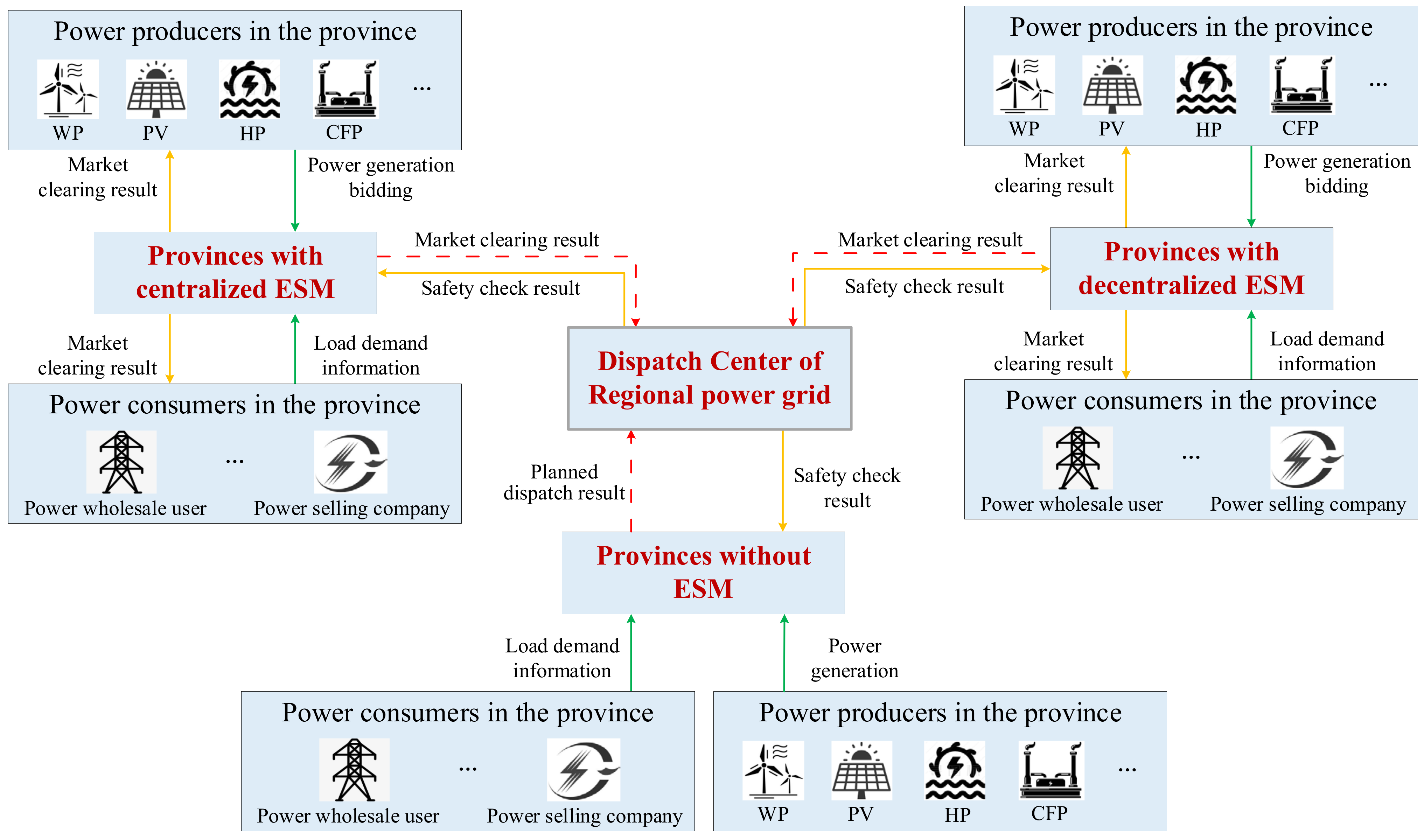

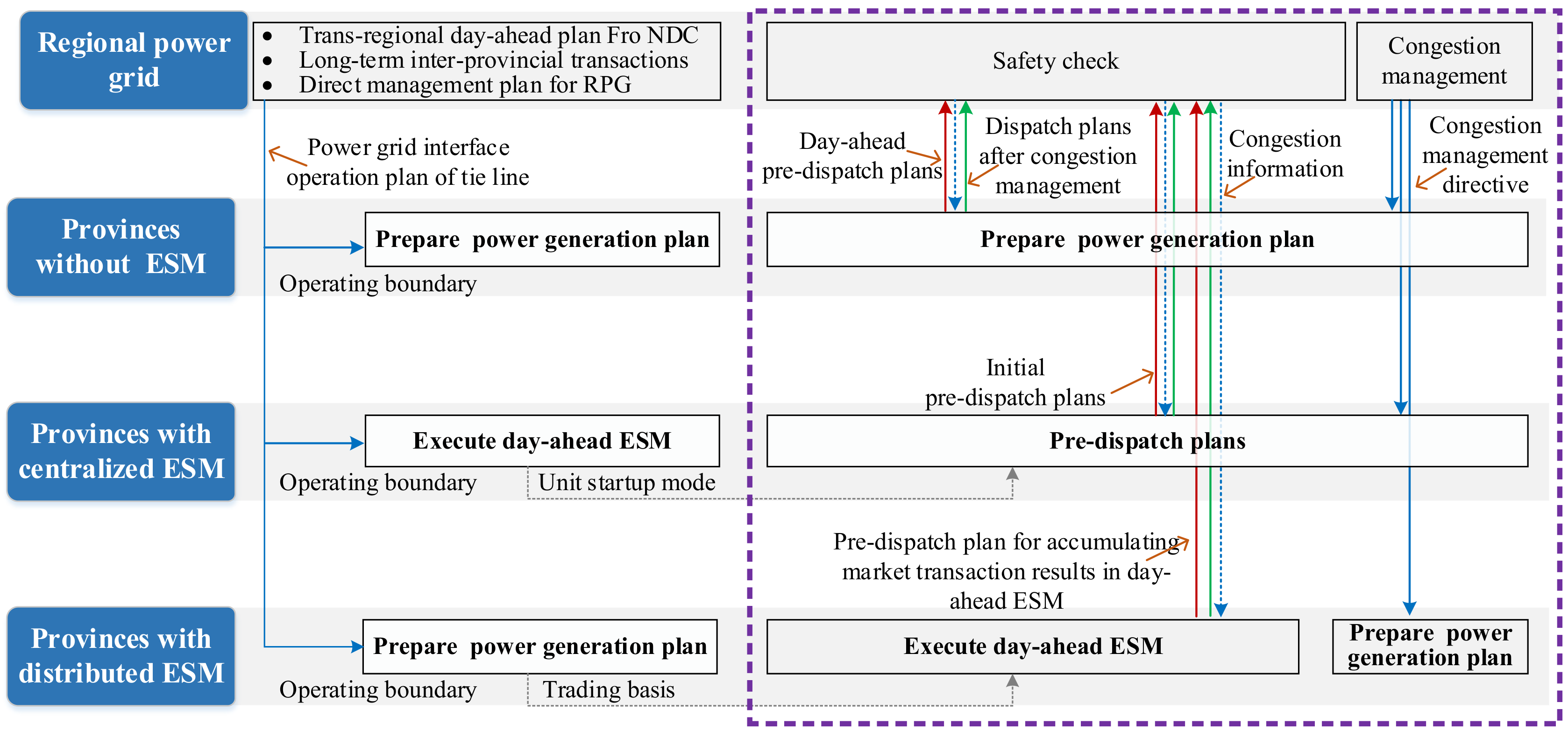



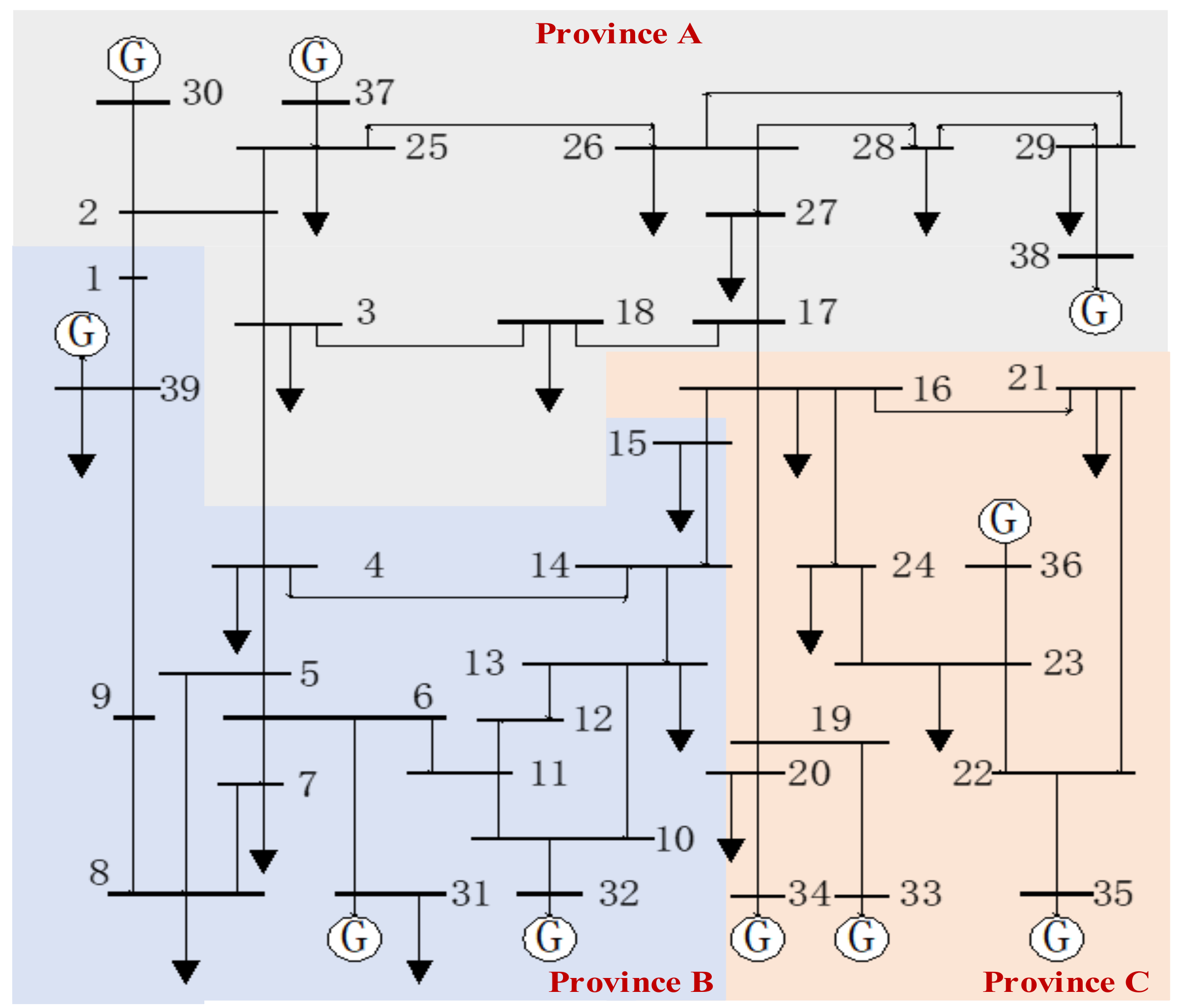
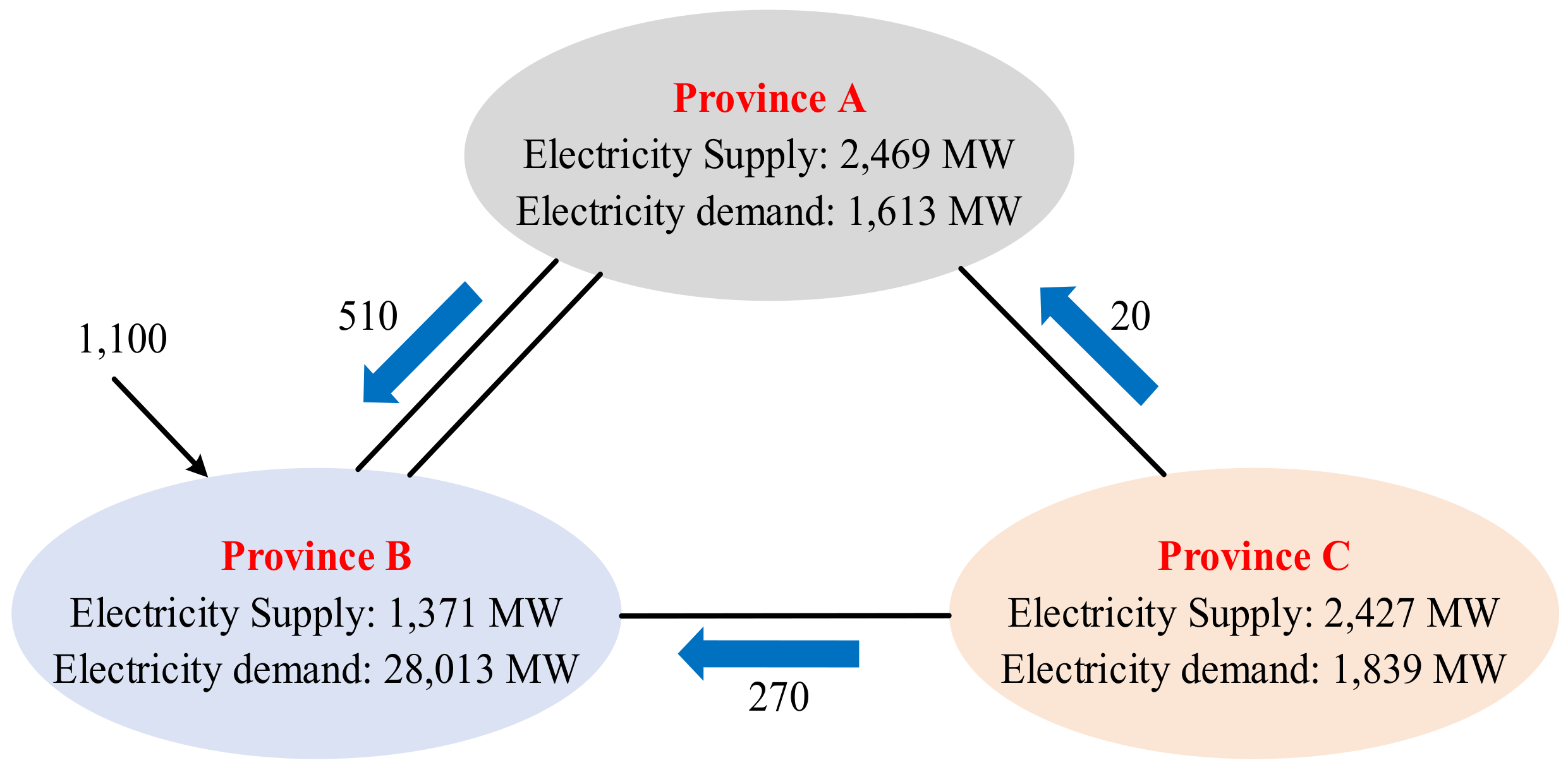
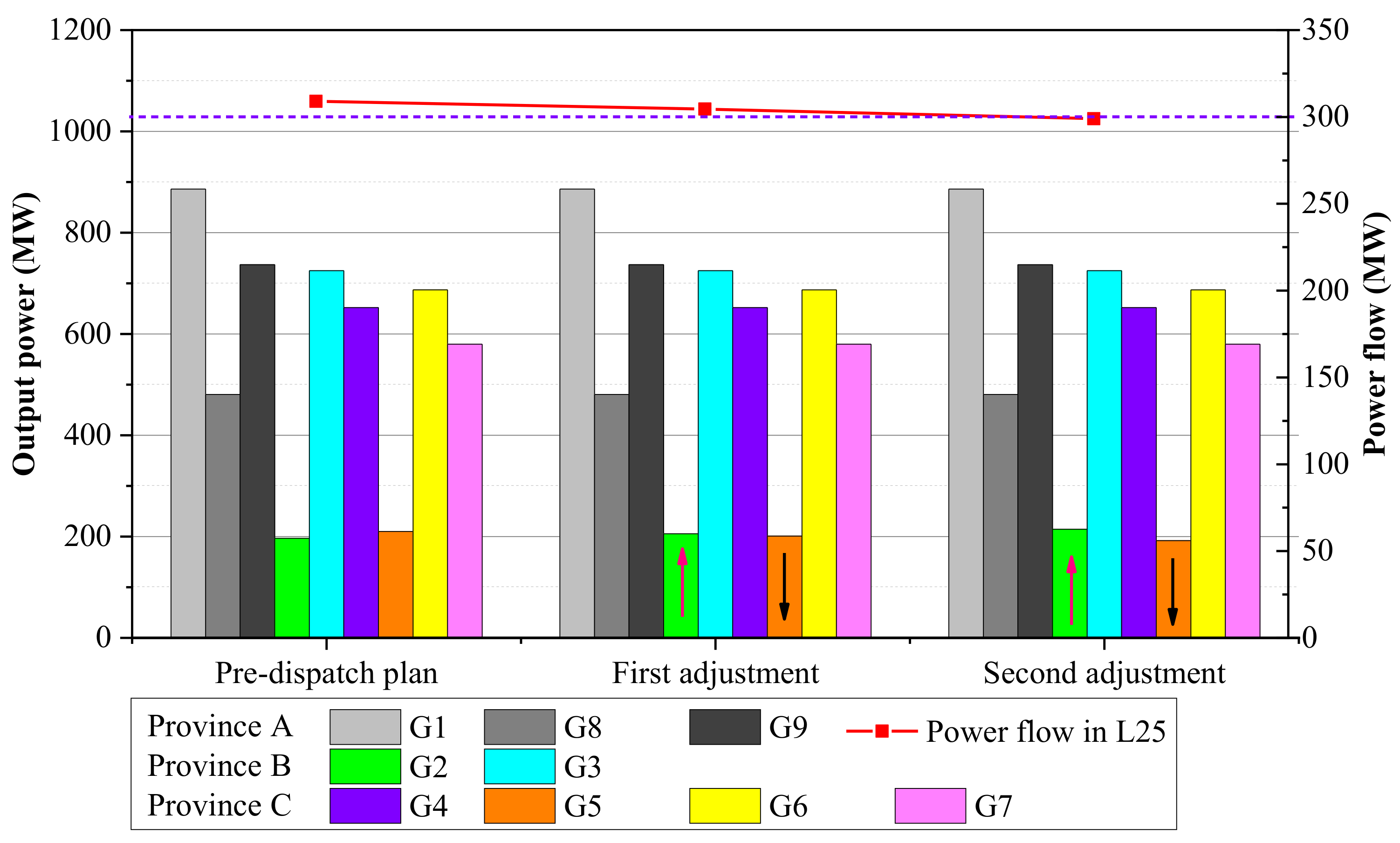


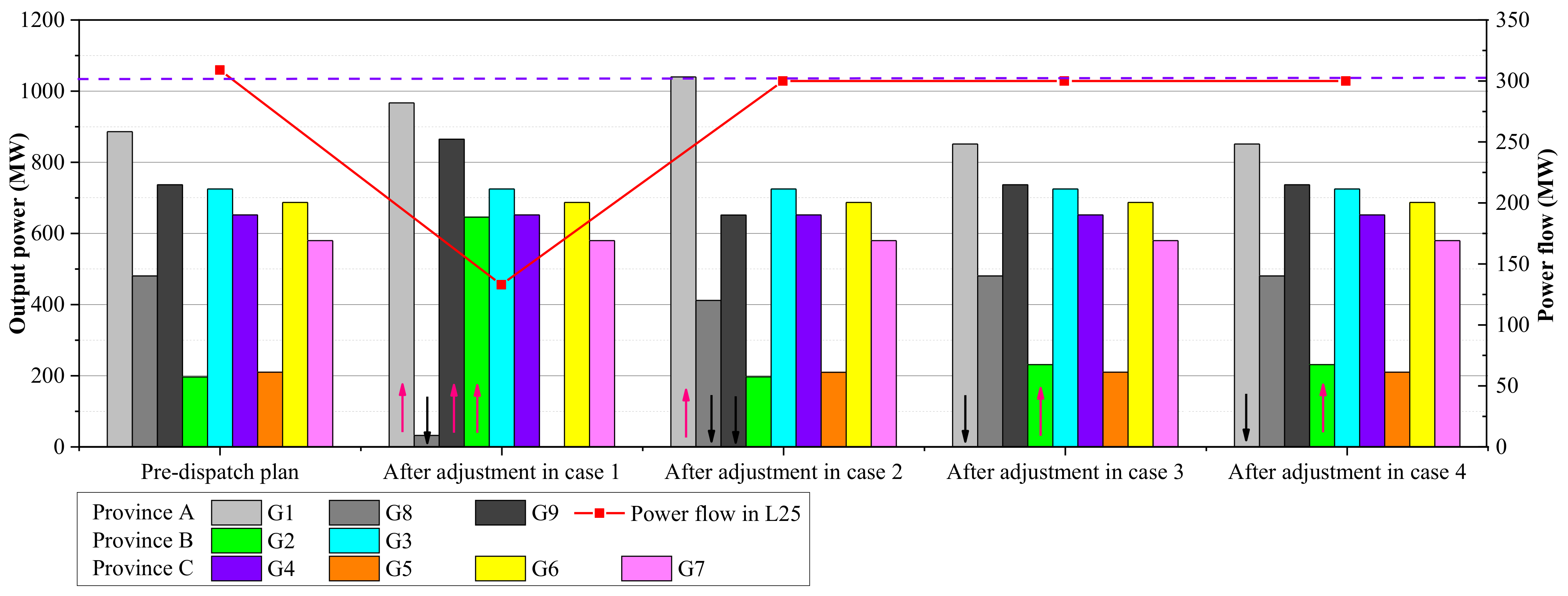
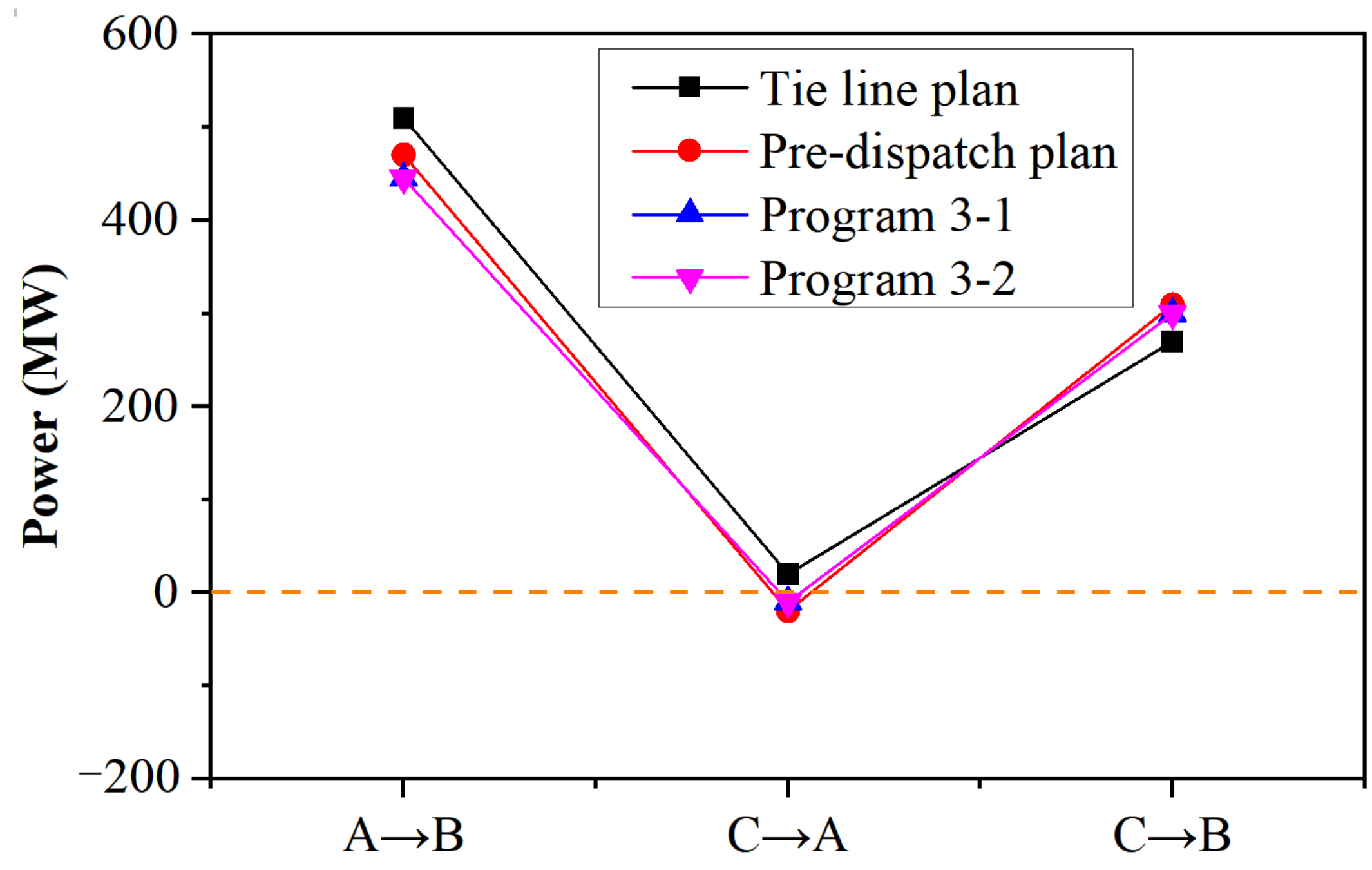
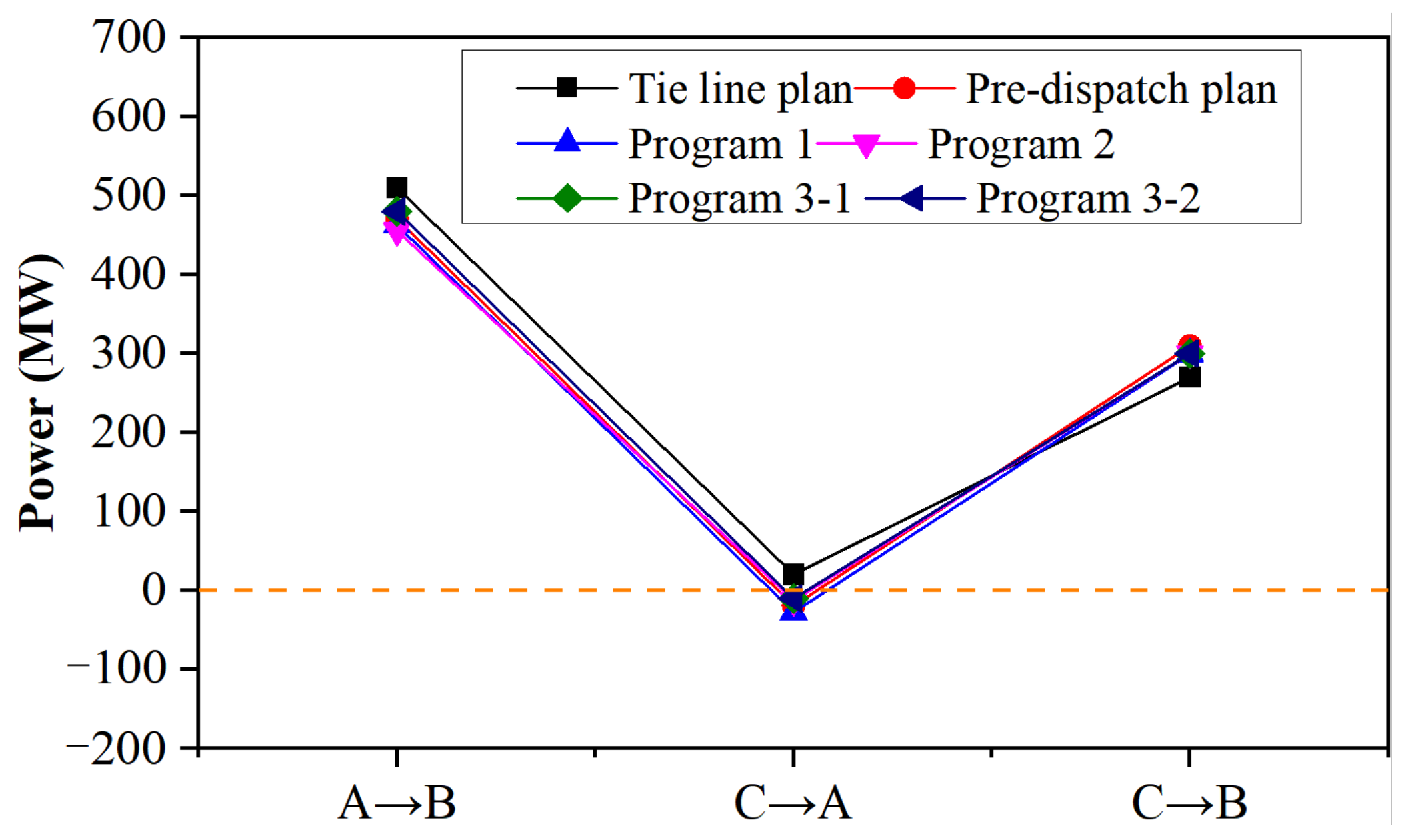
| Input Information for Safety Check and Congestion Management | |
|---|---|
| Dispatching center of RPG |
|
| |
| Dispatching center of the provincial power grid |
|
| |
| |
| |
| Output information for safety check | |
| Dispatching center of RPG |
|
| |
| |
| |
| Input Information for Safety Check and Congestion Management | |
|---|---|
| Dispatching center of RPG |
|
| |
| Dispatching center of the provincial power grid |
|
| |
| |
| |
| Output information for safety check | |
| Dispatching center of RPG |
|
| |
| |
| |
| Input Information for Safety Check and Congestion Management | |
|---|---|
| Dispatching center of RPG |
|
| |
| Dispatching center of the provincial power grid |
|
| |
| |
| Output information for safety check | |
| Dispatching center of RPG |
|
| |
| |
| Programs | Compliance Degree with Provincial Dispatching Plans | Mechanism Operation Efficiency | Fairness and Resource Allocation Efficiency |
|---|---|---|---|
| Program 1 | Strong | Low | Weak |
| Program 2 | Weak | High | Weak |
| Program 3 | Strong | High | Strong |
| Provinces | Market Model | Installed Capacity (MW) | Load (MW) |
|---|---|---|---|
| Province A | Without ESM | 2469 | 1613.5 |
| Province B | Centralized ESM | 2471 | 2801.63 |
| Province C | Decentralized ESM | 2427 | 1839.1 |
| Provinces | Province A | Province B | Province C | |||||||
|---|---|---|---|---|---|---|---|---|---|---|
| Unit number | G1 | G8 | G9 | G2 | G3 | G10 | G4 | G5 | G6 | G7 |
| Out power/MW | 886 | 480.5 | 736.9 | 196.6 | 725 | 1100 | 652 | 210.1 | 687 | 580 |
| Programs | Program 1 | Program 2 | Program 3-1 | Program 3-2 |
|---|---|---|---|---|
| Total iterations | 5000 | 5000 | 5000 | 5000 |
| Iterations in convergence | 2956 | 2915 | [3891, 3911, 3903] | [3615, 3805, 3711, 3708] |
| Time taken for convergence | 95 s | 89 s | [119 s, 126 s, 122 s] | [103 s, 116 s, 112 s, 109 s] |
Disclaimer/Publisher’s Note: The statements, opinions and data contained in all publications are solely those of the individual author(s) and contributor(s) and not of MDPI and/or the editor(s). MDPI and/or the editor(s) disclaim responsibility for any injury to people or property resulting from any ideas, methods, instructions or products referred to in the content. |
© 2025 by the authors. Licensee MDPI, Basel, Switzerland. This article is an open access article distributed under the terms and conditions of the Creative Commons Attribution (CC BY) license (https://creativecommons.org/licenses/by/4.0/).
Share and Cite
Li, Y.; Zhang, L.; Cong, Y.; Chen, H.; Zhang, F. Operation Optimization Model of Regional Power Grid Considering Congestion Management and Security Check in Complex Market Operation Environment. Processes 2025, 13, 336. https://doi.org/10.3390/pr13020336
Li Y, Zhang L, Cong Y, Chen H, Zhang F. Operation Optimization Model of Regional Power Grid Considering Congestion Management and Security Check in Complex Market Operation Environment. Processes. 2025; 13(2):336. https://doi.org/10.3390/pr13020336
Chicago/Turabian StyleLi, Yunjian, Lizi Zhang, Ye Cong, Haoxuan Chen, and Fuao Zhang. 2025. "Operation Optimization Model of Regional Power Grid Considering Congestion Management and Security Check in Complex Market Operation Environment" Processes 13, no. 2: 336. https://doi.org/10.3390/pr13020336
APA StyleLi, Y., Zhang, L., Cong, Y., Chen, H., & Zhang, F. (2025). Operation Optimization Model of Regional Power Grid Considering Congestion Management and Security Check in Complex Market Operation Environment. Processes, 13(2), 336. https://doi.org/10.3390/pr13020336





